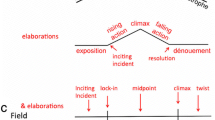Abstract
A dramatic work may be seen either as an event or as a text; the TEI guidelines make it possible to encode a dramatic work in either way, but do not attempt to solve the difficult problem of doing both at once. The basic element of a dramatic work, when seen as a text, is the speech; the guidelines also provide elements for encoding other familiar parts of dramatic texts (such as stage directions and cast lists), as well as for encoding analytic information on various aspects of texts and performances that is not normally included in printed dramatic texts. There are often other formal structures in dramatic works that intersect with the structure of speeches — metrical structures, for example; we discuss approaches for encoding these structures.
Similar content being viewed by others
References
Howard-Hill, T.H. “Modern Textual Theories and the Editing of Plays”.The Library, 6th ser., 11 (1989), 89–115.
Issacharoff, Michael and Robin F. Jones, eds.Performing Texts. Philadelphia: University of Pennsylvania Press, 1988.
Johannson, Stig. “The Encoding of Spoken Texts”. In This volume.
Shakespeare, William.The Complete Works. Ed. Stanely Wells, Gary Taylor, John Jowett and William Montgomer. Oxford: Clarendon Press, 1989. (Electronic Edition)
Sperberg-McQueen, C.M. “Text in the Electronic Age: Textual Study and Text Encoding, with Examples from Medieval texts”.Literary and Linguistic Computing, 6 (1991), 34–46.
Sperberg-McQueen, C.M. and Lou Burnard, eds.Guidelines for Electronic Text Encoding and Interchange (TEI P3). Chicago and Oxford: Text Encoding Initiative, 1994.
Thompson, Marvin and Ruth Thompson, eds.Shakespeare and the Sense of Performance. Newark: University of Delaware Press, 1989.
Author information
Authors and Affiliations
Additional information
John Lavagnino is a graduate student in English and American Literature at Brandeis University. His fields of interest include Renaissance drama, modern literature, textual scholarship, and electronic textuality. He is Electronics Editor ofThe Collected Works of Thomas Middleton (forthcoming from Oxford University Press).
Elli Mylonas is a Lead Project Analyst for the Scholarly Technology Group at Brown University. Formerly she was the Managing Editor of the Perseus Project. Her areas of interest are Roman poetry, textual markup and SGML, and hypertext.
The work described in this paper is the outcome of the discussions of the Performance Working Group, whose members are Elli Mylonas (chair), Rosanne G. Potter, John Lavagnino, and Lou Burnard. The authors wish to thank the other two members for their contributions.
Rights and permissions
About this article
Cite this article
Lavagnino, J., Mylonas, E. The show must go on:1 Problems of tagging performance texts. Comput Hum 29, 113–121 (1995). https://doi.org/10.1007/BF01830705
Issue Date:
DOI: https://doi.org/10.1007/BF01830705




